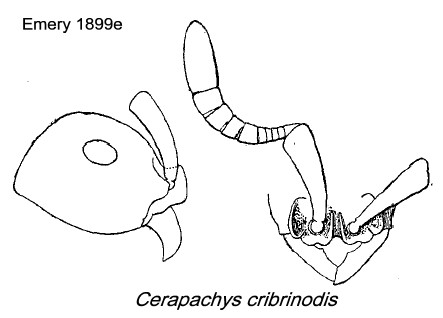Cerapachys cribrinodis (Emery)
  Type locality Cameroun (Parasyscia
cribrinodis n. sp.,
Emery, 1899e: 463, illustrated, worker; combination in Cerapachys,
Emery, 1902c: 24) collected at Johann-Albrechtsch÷he, by
Conradt; worker described (see Bolton, 1995) Type locality Cameroun (Parasyscia
cribrinodis n. sp.,
Emery, 1899e: 463, illustrated, worker; combination in Cerapachys,
Emery, 1902c: 24) collected at Johann-Albrechtsch÷he, by
Conradt; worker described (see Bolton, 1995)  . .
|
 Emery's
(1899e) description is at Emery's
(1899e) description is at  . .
Arnold (1915: 12) included a translation of the
original
Emery (1899e) description, as follows -
"Worker. TL 3.7 to 4 mm. Blackish brown, shining; the front of the
head, mandibles, antennae, tarsi, and apex of abdomen rusty red, last
joint of antennae and tarsi ferruginous.
Head a little longer than wide, the sides rounded, as wide in front as
behind and widely emarginate posteriorly; the posterior angles sub
acute. The eyes large and flat, inserted in about the middle of the
sides of the head; the frontal carinae fused with the clypeus, forming
on each side a projecting lobe, itself bilobed anteriorly. The antennae
are therefore placed farther forwards than in other species of the
genus; the frontal carinae are parallel in front, high and close
together, but separated by a groove; posteriorly they are fused
together and abruptly terminated by a depression continuous with the
antennal sockets. The genal carinae are raised anteriorly into a
prominence, below which is a depression sufficiently large to
accommodate the scape when the latter is directed forwards. Mandibles
narrow, their apical margin very oblique, with four small and obtuse
teeth at the base, and a larger obtuse tooth in the middle of the basal
margin.
Antennae 12-jointed, the scape reaches back to the posterior edge of
the eyes. All the joints of the funiculus are broader than long, except
the terminal joint which is as long as the four preceding taken
together.
The thorax is parallel-sided, depressed dorsally but not marginate and
without trace of sutures; the declivity of the propodeum finely
marginate.
Head and thorax smooth, sparsely and finely punctured, a hair being
inserted in each puncture. The puncturation of the petiole is much
coarser, that of the 1st abdominal segment a little smaller, the rest
of the abdomen finely punctured. The petiole is half as wide again as
long, truncate anteriorly and posteriorly, round above and not
marginate; below and in front there is a large rounded projection.
The 1st segment of the gaster is as wide at its base as the posterior
edge of the petiole, widening towards the apex ; the 2nd segment is
longer than the petiole, but the 2nd and following segments are
together shorter than the petiole plus the 1st segment. The legs are
hirsute.
Habitat - Cameroons".
Arnold added the type species does not occur in our region (Southern
Africa), but I have thought it best to reproduce the original
description which applies in the main to the following variety. ". NOTE
- The latter variety was natalensis, raised to
species by Brown (1975), and from South Africa.
Also from Za´re, 2
workers
found in the stomach of a toad (Lang & Chapin; in Wheeler,
1922). Bernard (1952) reported a single finding of 7 workers, from
KÚoulenta savanna, Guinea (27.iii.1942,
Lamotte); noting that they did not differ from the type of Emery, and
although it was a little known insect, it surely existed in all of
tropical Africa. Comparative notes can be found under Cerapachys
villiersi.
|